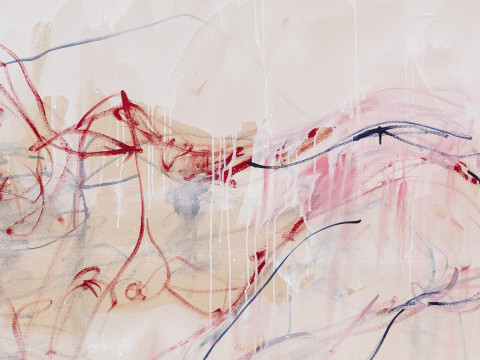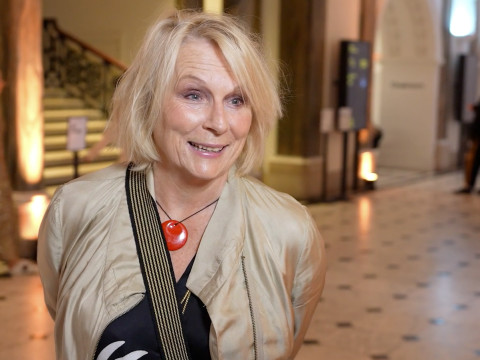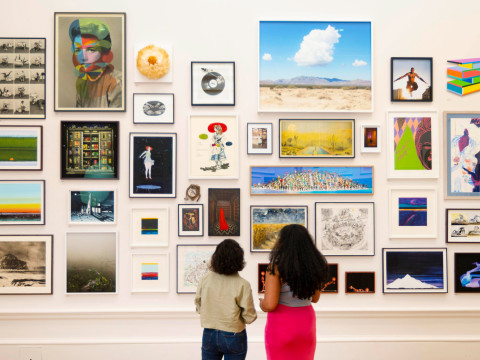
How to make a Summer Exhibition in 10 easy steps
Published on 11 June 2023
How do you put on a show of more than 1,500 works across 3,000 square metres for more than 200,000 visitors? By following an eccentric format perfected over 255 years – with a few contemporary tweaks, of course.

1. Committee: assemble!
Each year’s Summer Exhibition is brought into being by a small committee of artists and a dedicated team of RA staff. The artists and architects are selected on rotation from our Royal Academicians, which gives each year its own distinct character. They make all sorts of decisions – from which works are exhibited to what colour to paint the walls.
In 2024 the Summer Exhibition will be co-ordinated by sculptor Ann Christopher RA.

2. To theme, or not to theme?
One of the first of many tasks for the co-ordinator is deciding whether the show will have a theme – and if so, what? This new (and optional) tradition started around 20 years ago to create focus within the exhibition, and offer artists a concept to respond to. Recent themes have included ‘Climate’ (chosen by Alison Wilding for 2022) and ‘Reclaiming Magic’ (courtesy of Yinka Shonibare for 2021).

3. OK, world, let's see what you got…
Our founders decreed that the RA's annual exhibition should be “open to all Artists of distinguished merit”. More than 250 years on the Summer Exhibition is the largest open-submission art exhibition in the world.
Our founding document also stated that exhibited works could be sold through the show. Most of the profits from sales go to the artists and the rest is used to support the RA's charitable work, including training the next generation of artists for free at the Royal Academy Schools.
Submission to the Summer Exhibition opens at the start of each year. Anyone and everyone can throw their hat into the ring. Nowadays people submit photographs of their work online, but in earlier years things were more like this 1953 photo from our archive.

4. A very loooooooong meeting
Having received a hefty pile of submissions – capped at a mere 16,500 this year – the committee gathers for seven days of decision-making. With no artist names disclosed, the Members vote on whether each artwork should go through to the next round. If a work gets even a single yes-vote, it stays in the running. Together they manage to whittle the pile down to around 2,000 works.
2023 Co-ordinator David Remfry RA was well aware of the responsibility bestowed on the committee. He still remembers the first time his own submission was accepted in 1972 – “the joy of it!”. Does he have tips for those hoping to stand out to the judges now? “Other than sending in your best work, a couple of things... Frames! Keep it simple. Signatures! If you need to sign the work on the front, keep it very small and discreet.”

5. Shortlists and long-held traditions
Now the judges need to get their eyeballs on the real thing. During 'Delivery Week', all shortlisted works are brought to the Royal Academy.
Then in the course of just one long day, our art handlers show every artwork to the committee, presenting each one on a stool commissioned for this sole purpose in 1861. The stool has seen and heard it all: discussing, voting, re-discussing, re-voting – especially when members vie to have a work in their gallery over anyone else’s.
To keep their energy levels up, the committee drink beef tea, which is rumoured to contain beef, sherry, and other mysterious ingredients. The recipe remains closely guarded by our Red Collars – the all-in-one visitor hosts, security guards and knowledgeable guides who’ve been serving teapots of the stuff since the RA was founded in 1768.

6. Enough? No, more art!
Alongside entries from the open submission, some works will be specially commissioned for the exhibition. In 2015 Jim Lambie memorably transformed the stairs up to the Main Galleries with a kaleidoscope of colour. This year, look out for this dramatic mobile installation by Richard Malone, hung in the Wohl Central Hall.
To ensure each Summer Exhibition is the most eclectic spread of art being made now, the committee can also send a personal “invitation to submit” to artists who might not have considered entering.
The tradition was started in 2001 by Academician-and-artist-to-the-Beatles Peter Blake and curator Edith Devaney. Wanting to ensure the show would be fit for the 21st century, they spent the first months of the year knocking on the doors of exciting artists’ studios and dealers all over London to persuade them to submit to the show.

7. Hanging out, hanging art
With an almost final selection, it’s time to fill up those walls. In the exhibition’s early years, all paintings were arranged in symmetrical layouts, each with an ornate gold frame, tipped towards the viewer, and cheek by jowl with its neighbour.
Nowadays those hanging the Summer Exhibition can be more flexible in how and where works are displayed. With more than 1,500 pieces of art to fill 13 rooms of more than 3,000 square metres, it’s still no easy feat. Works can only be touched by our professional (and patient) art handlers, so the eight-day hang is an exercise in good communication, and remembering where you last saw that small one with the white frame.

8. Now for the finishing touches… Pass the gold leaf
Varnishing Day is another of the Summer Exhibition’s many traditions. Historically it was when artists could make any final tweaks to their work in situ. Today some artists still take the opportunity to make changes – in 2022 Boonserm Premthada followed in centuries of tradition by spending the day adding delicate gold leaf to his elephant dung installation.
Mostly, though, Varnishing Day is for celebration. The artists gather in our courtyard, form a procession down Piccadilly led by a steel band, attend a blessing at St. James’s church, and then head back to the RA for a first excited look at their work inside the show.

9. Paintbrushes down – it’s party time!
As well as being a fixture on the cultural calendar, the Summer Exhibition is an important fundraiser for the Royal Academy Schools, enabling us to offer free tuition to artists for the past quarter-millenium. So, when you need to raise cash for a good cause… you dig out your address book of famous art-lovers and invite them over for a party!
Our annual Summer Exhibition Preview Party gives art-enthusiast celebs one glitzy, star-studded, canapé-filled night to roam around the galleries and purchase works before we officially open. Then it’s time to refresh the champagne glasses for our Buyers Events – a time reserved for honouring all the art-lovers who bought from the previous Summer Exhibition by giving them an early chance to see and shop this year’s show.

10. Did anyone remember to order some red stickers?
Finally, we open the doors to the world. Before long the gallery walls fill with red stickers to indicate a work has sold – a system started at the 1865 show. The practice has since spread to art galleries and fairs across the world (trendsetters!).
In 2013, Royal Academician Cornelia Parker incorporated the red dots into her work. She exhibited her photo of one of the most-bought prints from the previous show (reportedly Tracey Emin’s), with the original work digitally removed but the red dots still present. Titled Stolen Thunder, you’ve probably spotted evolutions and re-works of the hit piece at every Summer Exhibition since. Several versions have even been bought by the government’s official art collection.
But you don’t have to be the Prime Minister to own a piece of the Summer Exhibition. Many works are available for less than £150, the Sales Desk is open to everyone, and you can also browse and buy online through the Summer Explorer.

The most important tradition of all – you
For more than 250 years the Summer Exhibition has been a social place to enjoy with friends and family; a place to see and be seen in the London summer scene. Looking back at the show throughout history, art historians Mark Hallett and Sarah Victoria Turner describe it as “a great urban spectacle, in which art, entertainment, commerce, education, and self-promotion have mingled together in a riot of colour and conversation.”
Today, some things are the same, and some have changed. We’d say it’s still a riot of colour, and perhaps even the world’s most joyful art experience.
Related articles

Who won prizes at Summer Exhibition 2024?
15 July 2024




